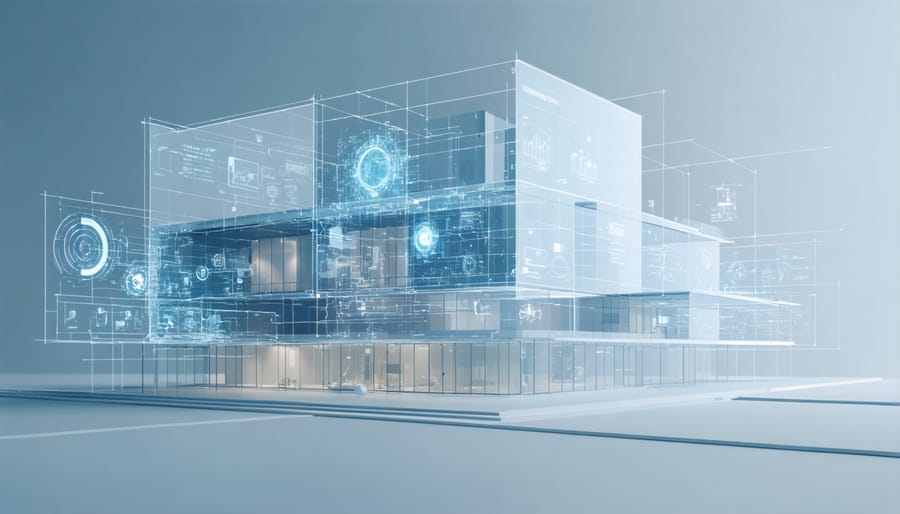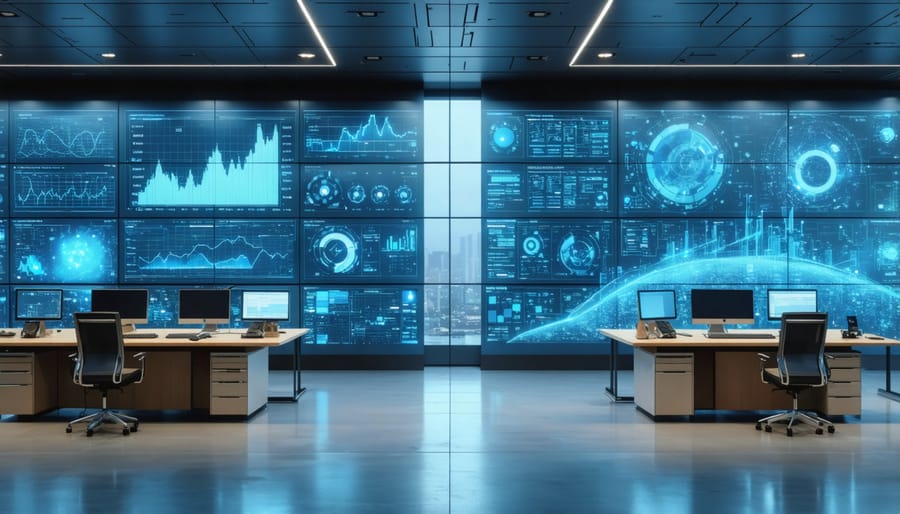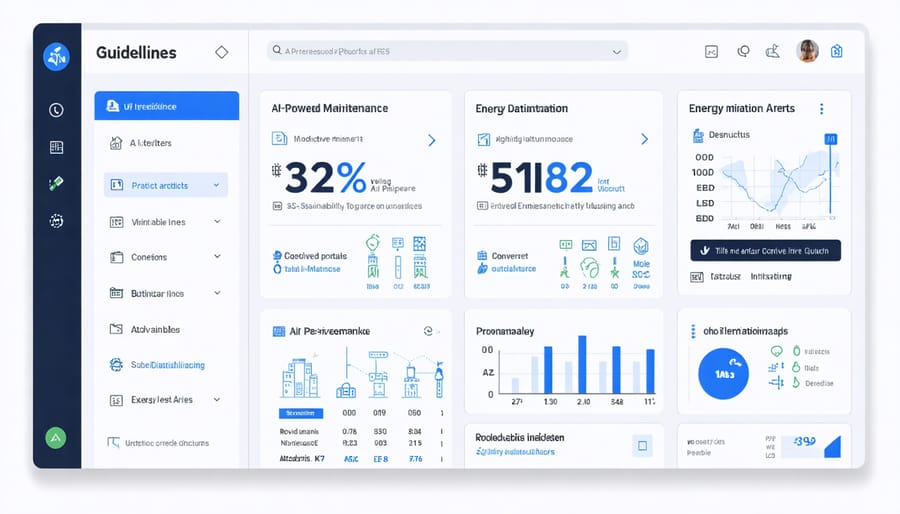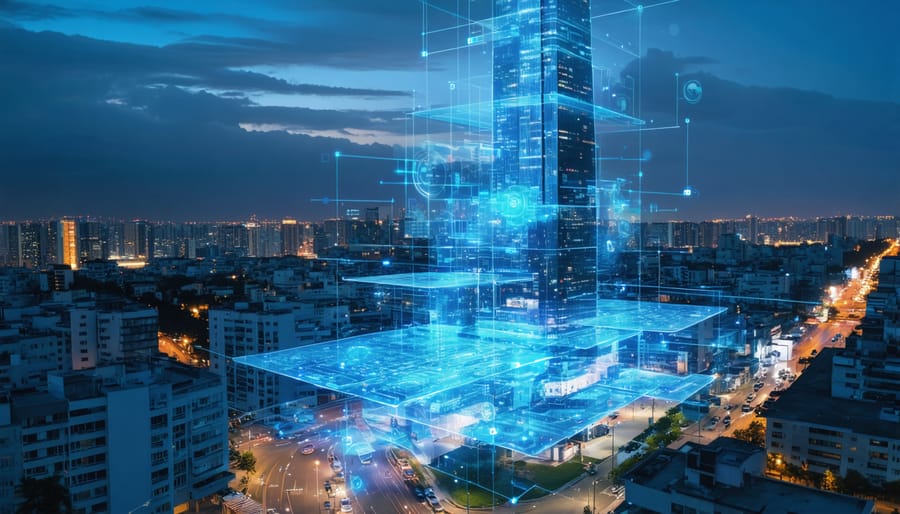Digital twin technology is revolutionizing urban development, creating virtual replicas of cities that transform how we plan, build, and manage urban infrastructure. As digital twins in construction become increasingly sophisticated, smart cities are leveraging this technology to optimize operations, enhance sustainability, and improve citizen services in real-time.
By combining IoT sensors, AI-driven analytics, and advanced 3D modeling, digital twin smart cities create living, breathing virtual environments that mirror their physical counterparts with unprecedented accuracy. This technology enables city planners, engineers, and administrators to simulate scenarios, predict outcomes, and make data-driven decisions that were previously impossible.
From traffic management and energy optimization to emergency response and urban planning, digital twins are providing cities with a powerful tool to address complex challenges while reducing costs and improving efficiency. Leading metropolitan areas worldwide are already demonstrating how this technology can transform urban environments into more resilient, sustainable, and livable spaces for their citizens.
This revolutionary approach to urban management represents not just an evolution in city planning, but a fundamental shift in how we conceive, build, and operate the cities of tomorrow.

The Digital Twin Revolution in Building Management
Real-Time Building Performance Monitoring
Digital twins enable unprecedented real-time monitoring capabilities for smart building technologies, creating a dynamic virtual replica that continuously captures and analyzes building performance data. Through an extensive network of IoT sensors, these systems monitor critical parameters including energy consumption, HVAC operations, occupancy patterns, and environmental conditions in real-time.
The collected data streams are processed through sophisticated analytics platforms that identify performance anomalies, predict maintenance needs, and optimize building operations automatically. Building managers can visualize complex system interactions through intuitive dashboards, enabling rapid response to issues and proactive optimization of building systems.
This continuous monitoring capability translates into tangible benefits: energy consumption reductions of 20-30%, decreased maintenance costs through predictive maintenance, and improved occupant comfort through automated environmental adjustments. The system’s machine learning algorithms continuously refine operational parameters based on historical performance data, creating an increasingly efficient and responsive building environment that adapts to changing conditions and usage patterns.
Predictive Maintenance and Asset Management
Digital twin technology revolutionizes asset management in smart cities by enabling predictive maintenance through real-time monitoring and data analytics. By creating virtual replicas of physical infrastructure, city managers can track asset performance, identify potential failures before they occur, and optimize maintenance schedules.
Advanced sensors and IoT devices continuously collect data on critical parameters such as vibration patterns, temperature fluctuations, and structural stress levels. This information feeds into the digital twin platform, where AI algorithms analyze performance trends and predict maintenance needs. The system can detect subtle changes in asset behavior that might indicate impending failures, allowing maintenance teams to intervene proactively.
The implementation of predictive maintenance strategies through digital twins typically reduces maintenance costs by 20-30% while extending asset lifecycles by up to 25%. Cities utilizing this approach report significant decreases in unexpected equipment failures and service disruptions. For example, Singapore’s digital twin implementation has helped optimize the maintenance of public infrastructure, resulting in a 15% reduction in maintenance-related downtime.
Asset managers can also simulate different maintenance scenarios and their potential impacts, enabling data-driven decisions about resource allocation and maintenance prioritization. This capability ensures optimal performance of city infrastructure while maximizing return on investment.
Integration Challenges and Solutions
Data Infrastructure Requirements
A robust data infrastructure forms the backbone of any digital twin smart city implementation, requiring a multi-layered technological framework that supports real-time data collection, processing, and analysis. At its foundation, a high-speed fiber-optic network serves as the primary communication channel, complemented by 5G wireless connectivity to ensure comprehensive coverage and minimal latency.
The infrastructure must incorporate an extensive network of IoT sensors and actuators strategically positioned throughout the urban environment. These devices continuously collect data on various parameters including traffic flow, energy consumption, air quality, and structural health of buildings. Edge computing systems process this data locally to reduce bandwidth requirements and enable immediate response to critical situations.
Cloud computing platforms provide the necessary scalability and storage capacity for handling massive datasets, while specialized data centers equipped with high-performance computing capabilities support complex simulations and predictive analytics. The system architecture must include robust cybersecurity measures, including end-to-end encryption and advanced authentication protocols, to protect sensitive urban data.
Integration layers and APIs facilitate seamless communication between different subsystems, while artificial intelligence and machine learning algorithms analyze patterns and generate actionable insights. Real-time visualization platforms transform raw data into intuitive 3D models, enabling stakeholders to monitor and manage city operations effectively.

Security and Privacy Considerations
The implementation of digital twin smart cities necessitates robust cybersecurity frameworks and comprehensive data protection protocols. As these systems collect and process vast amounts of sensitive urban data, protecting against cyber threats becomes paramount for maintaining operational integrity and public trust.
Multi-layered security architectures are essential, incorporating encryption protocols, access control systems, and real-time threat monitoring. Organizations must implement end-to-end encryption for data transmission and storage, while ensuring secure authentication mechanisms for all system users and connected devices.
Data privacy considerations extend beyond technical measures to include regulatory compliance with frameworks such as GDPR and local data protection laws. Smart city administrators must establish clear data governance policies, defining data collection purposes, storage duration, and usage limitations. Regular privacy impact assessments help identify potential vulnerabilities and ensure appropriate safeguards are in place.
Physical security measures are equally important, protecting edge computing devices, sensors, and critical infrastructure components from tampering. Regular security audits, penetration testing, and vulnerability assessments should be conducted to maintain system resilience.
Stakeholder collaboration is crucial for maintaining security standards. This includes establishing incident response protocols, conducting regular staff training on cybersecurity best practices, and maintaining open communication channels with cybersecurity experts and relevant authorities. Success in digital twin implementation relies heavily on building and maintaining public confidence through demonstrated commitment to security and privacy protection.
Case Study: Digital Twin Implementation Success
The Capital Tower in Singapore stands as a prime example of successful digital twin implementation in commercial building management. In 2019, CapitaLand, in partnership with Dassault Systèmes, deployed a comprehensive digital twin solution that transformed the 52-story building into a smart facility.
The project began with the creation of a detailed 3D model incorporating over 50,000 data points from various building systems, including HVAC, lighting, security, and occupancy sensors. Real-time data integration allowed facility managers to monitor and optimize building performance through a unified dashboard system.
Key achievements of the implementation include:
• 25% reduction in energy consumption within the first year
• 18% decrease in maintenance costs
• 35% improvement in facility response time
• 40% enhancement in occupant satisfaction ratings
The digital twin system enabled predictive maintenance by analyzing equipment performance patterns. For instance, when the HVAC system showed early signs of inefficiency, the platform automatically alerted maintenance teams before any noticeable impact on occupant comfort occurred.
The implementation process followed a phased approach:
1. Initial scanning and modeling (3 months)
2. Sensor network installation (2 months)
3. System integration and testing (4 months)
4. Staff training and optimization (3 months)
ROI analysis revealed that the initial investment of $2.8 million was recovered within 2.5 years through operational savings and improved tenant retention. The building’s operational efficiency metrics now consistently outperform similar-sized structures by 30%.
Perhaps most notably, the digital twin platform proved invaluable during the COVID-19 pandemic, enabling remote building management and automated adjustment of ventilation systems based on occupancy patterns. The system’s success has led CapitaLand to implement similar solutions across their portfolio, establishing a new standard for smart building management in Southeast Asia.
Future-Proofing Smart Buildings
AI and Machine Learning Integration
The integration of AI and machine learning technologies serves as the cognitive engine of digital twin smart cities, enabling sophisticated data analysis and automated decision-making processes. Advanced algorithms process vast amounts of real-time data from IoT sensors, creating predictive models that optimize city operations across multiple domains. These systems excel at identifying patterns and anomalies, allowing for AI-powered predictive maintenance of critical infrastructure and utilities.
Machine learning models continuously improve their accuracy through iterative learning, adapting to changing urban conditions and requirements. This dynamic capability enables proactive resource management, from traffic flow optimization to energy consumption forecasting. Deep learning algorithms analyze complex urban datasets, providing insights that help city planners make data-driven decisions about infrastructure development and public service delivery.
The combination of AI and digital twin technology creates a powerful framework for scenario testing and urban planning simulations, allowing stakeholders to evaluate the impact of proposed changes before implementation. This reduces risks and optimizes resource allocation while ensuring sustainable urban development.

Sustainability and Energy Optimization
Digital twin technology plays a crucial role in advancing sustainable building practices and optimizing energy consumption within smart cities. By creating virtual replicas of urban infrastructure, operators can monitor and analyze energy usage patterns in real-time, enabling precise adjustments to building systems for maximum efficiency.
Recent implementations have demonstrated energy savings of 20-30% through predictive maintenance and automated system optimization. Digital twins facilitate the integration of renewable energy sources by simulating various scenarios and identifying optimal placement for solar panels, wind turbines, and energy storage systems.
The technology also enables sophisticated carbon footprint tracking across city districts, helping municipalities achieve their sustainability goals. Through continuous monitoring and AI-driven optimization, digital twins can automatically adjust HVAC systems, lighting, and power distribution based on occupancy patterns and environmental conditions. This dynamic response capability not only reduces energy waste but also extends the lifespan of building systems while maintaining optimal comfort levels for occupants.
Digital twin smart city implementation offers transformative benefits for urban development and management, from enhanced operational efficiency to improved sustainability and citizen services. By creating virtual replicas of urban infrastructure, stakeholders can simulate scenarios, optimize resources, and make data-driven decisions with unprecedented accuracy. The technology has demonstrated significant ROI through reduced maintenance costs, improved energy efficiency, and enhanced infrastructure lifecycle management.
To successfully implement digital twin technology, cities should begin with a clear strategy and phased approach. Start by identifying high-priority areas for implementation, such as traffic management or utility networks. Establish robust data collection infrastructure and ensure interoperability between systems. Partner with experienced technology providers and engage stakeholders early in the process. Investment in proper training and change management is crucial for successful adoption.
Looking ahead, cities that embrace digital twin technology will be better positioned to address urban challenges, meet sustainability goals, and deliver superior services to their citizens. The key to success lies in careful planning, strategic implementation, and ongoing commitment to digital transformation.

